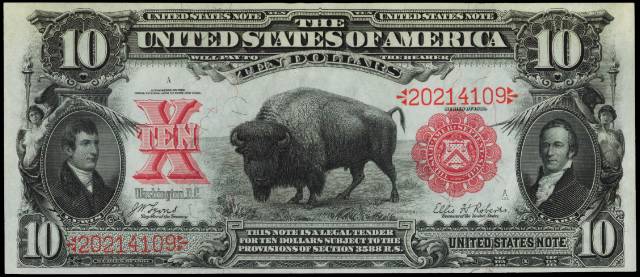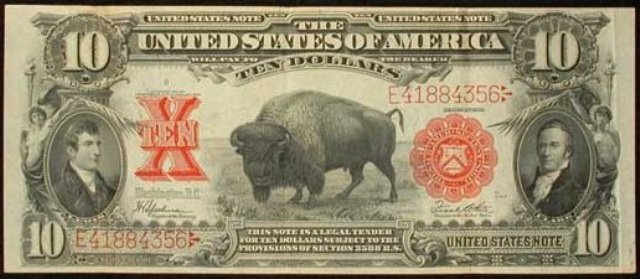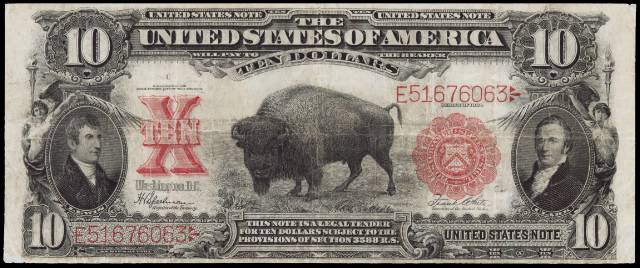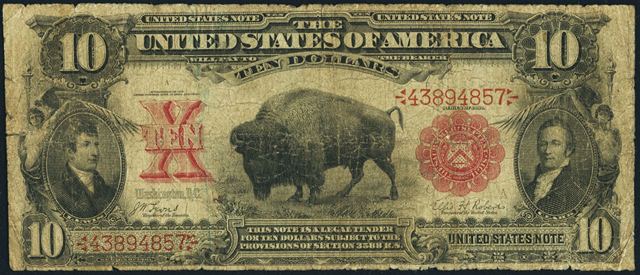Series of 1901 $10 Legal Tender – Bison Note
History: There might not be a more popular large size United States note than the series of 1901 $10 legal tender note. The very first ten dollar legal tenders were issued in the 1860s and featured Abraham Lincoln. That note was redesigned and from 1869 until 1900 all $10 legal tenders issues by the U.S. had a picture of Daniel Webster. As you can imagine, that design got a bit stale after 30 years. In 1901 the country was introduced to the series of 1901 bison note. This note has historical appeal as well as numismatic appeal. It was circulating during the 100 year anniversary of the Lewis and Clark expedition. Based on signature combinations, we know that the bison notes were being printed until the early 1920s.
Nickname: This nickname is pretty obvious. Most everyone simply calls this note a bison. Some people mistakenly call it a buffalo note and a few even call it a Lewis and Clark note. Everyone will still know what you are talking about if you says 1901 $10 bill – but it is much easier to just say bison (this is after all the only piece of US money with a bison on it).
Other Facts: One of the greatest misconceptions about the bison note is that the bison pictured is the now famous animal named Black Diamond. Black Diamond is recorded as being the model for the bison featured on the buffalo nickel. He was not in fact the model for the 1901 $10 bill. According to research, the original engraving is based on a stuffed bison that was on display at the Smithsonian in the late 19th century. That specific bison was apparently shot in Montana in 1886. That is certainly a more interesting history than that of the zoo held Black Diamond.
Values and Grading: The 1901 $10 bison is not a rare note. You can pretty much buy one at will from any dealer, and basically every collector has one in his or her holdings. With that said, despite being relatively common, popularity drives the value of most bison notes. The exact value all comes down to condition, serial number, and signature combination. Any bison note that has a serial number that begins with a star symbol is fairly rare. Prices start at $1,500 and go up very quickly based on condition. That price point only applies to star notes. There are also nine different signature combinations for this bill. In some markets there might be a 10% premium for one of the tougher combinations. However, most people are buying for the imagery not for the name. Outside of the serial number and signature combination, the value all comes down to the condition, aka grade. Learn more about grading below.
Choice Uncirculated or Better: It is far from impossible to get a choice uncirculated bison. Lots of them are out there. They are not rare, just expensive. Depending on the actual numeric grade, prices start as low as about $5,000 and go up from there. There are some type notes where you have to have a gem example to really appreciate it. We don’t feel that the bison is one of those. There are plenty of lower grade examples that are just as pleasing that might only cost you a fraction of what an uncirculated example would.

This Exact Note Would Sell For $8,000+
Extremely Fine to About Uncirculated: The actual note pictured below would probably grade something like a very fine 35. On a good day it could be something like an XF 40. You can see that it has really strong paper. Look at how the paper easily holds the fold (especially the fold on the far right). That is a sign that the money has not been messed with. A bison in this condition should sell for just over $1,000 in today’s market. The same 1901 $10 bill with just one fold could sell for as much as $3,000. You can see that there is a wide price range between three folds and one fold. No folds would mean that the note is uncirculated.

This Exact 1901 $10 Bill Would Sell For Around $1,250
Fine to Very Fine: Most people looking to purchase a bison note are going to want something in the fine to very fine grade. These can sell for as little as $500 or as much as $1,000. The different price points are really established based on condition. The note we have pictured below has been graded as a Fine 15. It has also likely been washed and pressed. That is why the fold lines are so white and why the red seal has taken on a slightly pink color.

This Exact Bison Would Likely Sell For Around $600
Very Good and Lower: Don’t ask us why, but most of the bisons we see from members of the public tend to be heavily circulated. Maybe $10 was the bill of choice to handle a grocery bill or a nice meal out in the 1901 to 1920 era. Whatever it was, lots of bison notes are heavily used like the one you see below. It is not unusual to see tears, tape, or writing. Missing pieces and rough margins define the grade. 1901 $10 bills in this grade shouldn’t sell for more than a few hundred dollars and most are worth less. A collector can buy a nice VF example for $1,000, so there is really not much incentive to be cheap and get a ragged specimen.

This Exact 1901 $10 Note Should Sell For About $300
Need an Appraisal or Offer? There is great demand for 1901 $10 bills. We are always looking to buy for our personal collections and inventory. If you would like to know the current market value of your note then just send pictures of the front and back. We will respond back quickly with our opinion on the value and give you our best offer. Sales@AntiqueMoney.com


